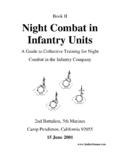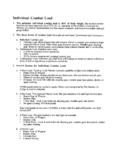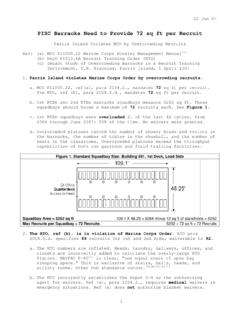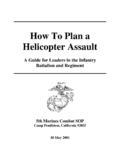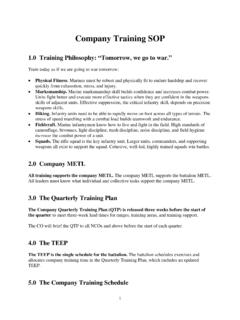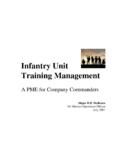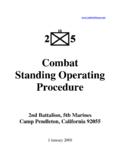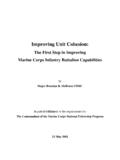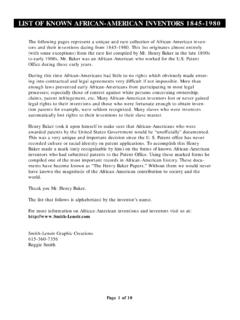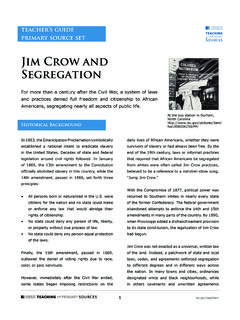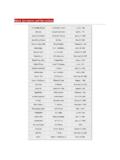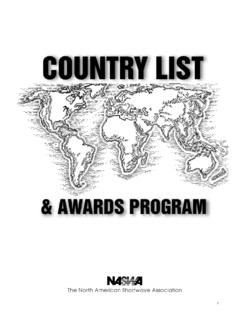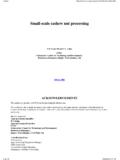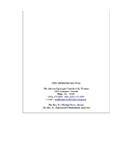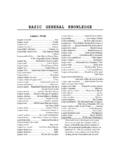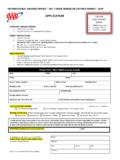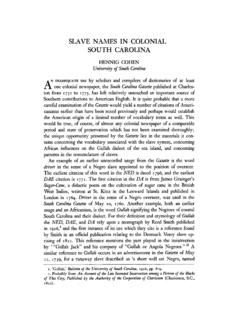Transcription of DEFEAT AT KASSERINE: AMERICAN ARMOR …
1 DEFEAT AT kasserine : AMERICAN ARMOR DOCTRINE, training , and battle command IN NORTHWEST AFRICA, WORLD WAR II A thesis presented to the Faculty of the Army command and General Staff College in partial fulfillment of the requirements for the degree MASTER OF MILITARY ART AND SCIENCE Military History by MARK T. CALHOUN, MAJ, US ARMY , University of Southwestern Louisiana, Lafayette, Louisiana, 1988 Fort Leavenworth, Kansas 2003 Approved for public release; distribution is unlimited. iiMASTER OF MILITARY ART AND SCIENCE THESIS APPROVAL PAGE Name of Candidate: Major Mark T. Calhoun Thesis Title: DEFEAT at kasserine : AMERICAN ARMOR Doctrine, training , and battle command in Northwest Africa, World War II Approved by: _____, Thesis Committee Chair Christopher R.
2 Gabel, _____, Member Lieutenant Colonel Marlyn R. Pierce, Accepted this 6th day of June 2003 by: _____, Director, Graduate Degree Programs Philip J. Brookes, The opinions and conclusions expressed herein are those of the student author and do not necessarily represent the views of the Army command and General Staff College or any other governmental agency. (References to this study should include the foregoing statement.) iiiABSTRACT DEFEAT AT kasserine : AMERICAN ARMOR DOCTRINE, training , and battle command IN NORTHWEST AFRICA, WORLD WAR II, by Major Mark T. Calhoun, 97 pages. The 1st Armored Division was the first AMERICAN armored unit to enter combat against German panzer divisions in World War II.
3 A product of the contentious mechanization process between the First and Second World Wars, the division soon found itself to be outmatched by its German foe. Following a relatively easy victory against the Vichy French after the amphibious landings of Operation Torch, the division lost a series of battles to the Germans, culminating in a decisive DEFEAT at kasserine Pass. Doctrine (both institutional and equipment), training , and battle command all proved to be problematic for the division. The central question is: Did the 1st Armored Division lose the battle of kasserine Pass because of deficiencies in AMERICAN ARMOR doctrine, training , or battle command ?
4 An analysis of the Tunisian campaign focusing on these three areas demonstrates that faulty training and inept battle command were partially responsible for the division s DEFEAT ; however, the primary reason the 1st Armored Division lost the battle of kasserine Pass was that it operated in accordance with flawed institutional doctrine and utilized inferior equipment. ivACKNOWLEDGMENTS I would like to thank my family for their patience and understanding as I undertook this time-consuming project, and my committee for their guidance that helped me to focus my energies and organize my thoughts. vTABLE OF CONTENTS Page THESIS APPROVAL PAGE.
5 Ii ABSTRACT .. iii ACKNOWLEDGMENTS .. iv ACRONYMS .. vi LIST OF vii CHAPTER 1. INTRODUCTION .. 1 2. THE ROAD TO 9 3. 28 4. 50 5. BATTLE 62 6. 73 83 89 BIBLIOGRAPHY .. 90 INITIAL DISTRIBUTION LIST .. 95 CERTIFICATION FOR MMAS DISTRIBUTION 96 viACRONYMS AP ARMOR Piercing CARL Combined Arms Research Library, Fort Leavenworth, Kansas CCA Combat command A CCB Combat command B CCC Combat command C CCD Combat command D FM Field Manual GHQ General Headquarters HE High Explosive HEAT High-Explosive Antitank SP Self-Propelled TC training Circular viiILLUSTRATIONS Figure Page 1. US Armored Division Structure, 83 2.
6 US Armored Division Structure, 1942 .. 83 3. M3A1 Stuart Light Tank .. 84 4. M3A3 General Lee Medium Tank .. 85 5. Map 1, Operation 86 6. Map 2, Race for Tunisia and Axis 87 7. Map 3, kasserine 88 1 CHAPTER 1 INTRODUCTION In June 1942, as the AMERICAN 1st Armored Division made its final preparations to deploy to Northern Ireland and prepare for its entry into the war in Europe, it was not preparing to face Field Marshal Erwin Rommel s Afrika Corps. The division was preparing to participate in an invasion of Europe, aimed at liberating France, striking into Germany, and bringing an early end to World War II. While the Combined Chiefs of Staff were planning this operation, two very powerful men had a different idea, for different reasons.
7 President Franklin D. Roosevelt wanted to get AMERICAN soldiers into combat against Germans as soon as possible, certainly in 1942, and no cross-channel invasion could be planned and executed that quickly. British Prime Minister Winston Churchill opposed making the initial thrust against Germany a cross-channel invasion, preferring to attack through Europe s soft underbelly instead, a position he had also maintained in World War In the midst of military planning for an invasion of Europe, these two men made the decision to invade North Africa in 1942, putting the cross-channel invasion off until at least Thus began the planning for Operation Torch, an Allied amphibious invasion of Northwest Africa.
8 This sudden change of plans posed a number of challenges to the Allied forces, such as assembling a fleet large enough to transport invading forces 4,000 miles to North Africa, attempting to negotiate with Vichy French forces occupying Northwest Africa to forestall organized resistance to the landings, and shifting planning efforts to rapidly prepare for ground combat in Tunisia. The change also posed a major challenge to the 2 AMERICAN divisions chosen to invade Northwest Africa. The 1st Armored Division and the 1st and 34th Infantry Divisions were chosen to make the landings at Algiers and Oran. The 2nd Armored Division and the 3rd and 9th Infantry Divisions were selected to land to the west and secure French Morocco.
9 These divisions were chosen not because they were the best prepared, but because they were the only units available. The Allied invasion force that landed in Northwest Africa during Operation Torch faced the Germans much earlier than planned, in a different theater than expected, with equipment that was inferior to that possessed by the Germans and with a severe disadvantage in experience. The fighting in Tunisia was some of the toughest the Americans faced in the European theater, and despite initial setbacks, they emerged a stronger, battle-hardened force, ready to face the challenges that awaited them in Sicily, Italy, Normandy and beyond.
10 The Allies participating in Operation Torch faced an enemy of dubious quality. The armistice established after the fall of France in June 1940 installed a new French government in Vichy, led by Marshal Henri Philippe Petain. German forces occupied the northern portion of France, while Vichy French forces remained in the southern portion of France and their North African territories. The Vichy French forces in Northwest Africa, consisting of about 135,000 men in 1942, were seriously constrained by the terms of the armistice. The Germans did not allow them to possess heavy artillery, antitank pieces, antiaircraft guns or motorized infantry, although they did leave French naval forces undisturbed.

